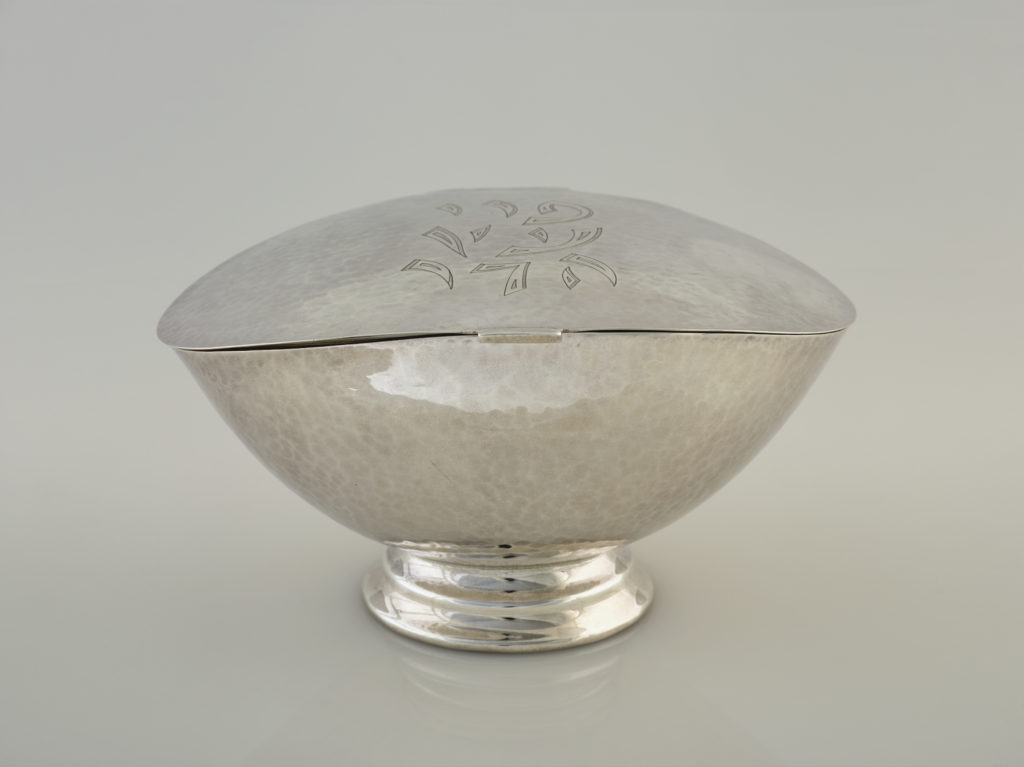Contenedor Etrog (obra de arte)
Información sobre la obra de arte
Key Ideas
- El artista utilizó un martillo especial y punzones de metal para empujar el metal desde la parte trasera o delantera de esta caja, para subir y bajar la plata y crear su diseño único.
- Etrog cases protect the delicate citron, or citrus fruit, used throughout the Jewish eight-day festival of Sukkot (soo-coat).
- Ludwig Yehuda Wolpert was born in Hildesheim, where he grew up in an observant Jewish family. As a young man, he studied at the School for Arts and Crafts in Frankfurt-on-the-Main. After a few years working as a sculptor, Wolpert returned to the school and specialized in metalwork. In 1933 he immigrated to British Palestine and became well-known for his Jewish ceremonial art.
- Etrog cases are available in a wide variety of materials and designs. These include elaborate silver boxes, rectangular vinyl bags, and cases made of wood, leather, and plastic.
Más información
Sukkot is both an ancient harvest festival and a commemoration of the 40-year wandering of the Israelites in the wilderness. The agricultural aspect of the eight-day holiday is evident in the ritual involving an etrog, which is a citron or citrus fruit, and lulav (loo-love), which are bound stems of palm, willow, and myrtle leaves. The etrog is often kept in a special protective case.
El etrog es un cítrico amarillo que se cultiva principalmente se cultiva sobre todo en Italia, Grecia, Israel y algunos países de América Central y del Sur. El etrog, muy perfumado y más grande que un limón, se utiliza como complemento del lulav durante la fiesta de Sucot. Es importante que el etrog se guarde en una caja protectora, ya que esta frágil fruta no puede utilizarse si su piel o pitom (pee-tome), que es el capullo adherido a la fruta, están dañados.
The earliest and most prized etrog cases were produced by skilled craftspeople in Augsburg and other cities in the German states, or principalities, during the 1600s. In the early 1700s, a common household container known as a Zuckerdose (which was used to store sugar in many German homes) was used as an etrog case for one week each year.
As part of the concept of hiddur mitzvah (finding ways to beautify or elevate Jewish rituals and religious commandments), the ideal etrog has no blemishes and the pitom (or pistil) on top is intact and undamaged. It is important to protect the etrog and ensure that it remains undamaged during Sukkot. The etroggim (plural form) that were not used during Sukkot had various other uses. The thick peel was either pickled in vinegar or boiled to a pulp and eaten, or the fragrance from the peel was extracted and used as perfume. According to the Jewish text the Talmud, the etrog was also highly valued as an antidote to poisonous snake bites.The English translation of the case’s engraved Hebrew script is ”the fruit of a goodly tree” (Leviticus 23:40). The Hebrew Bible refers to a tree described as hadar, which means “splendid” or “majestic.”
Recursos adicionales
Recursos para los profesores:
- Lea un artículo y vea dos vídeos sobre el uso del lulav y el etrog.
- Lea un breve artículo sobre Ludwig Yehuda Wolpert.
- Explore las técnicas que se utilizaron para crear y decorar esta caja de etrog.
Recursos para los estudiantes:
- Examine otra caja de etrog de la colección del Museo Judío de Londres. Desplácese por las imágenes para ver las escenas de la caja que hacen referencia a las fiestas de Sucot, Rosh Hashaná y Shavuot. Estas eran las tres fiestas de peregrinación en la época del antiguo Templo de Jerusalén.
- Vea un vídeo para saber cómo se usan el lulav y el etrog durante Sucot.
- Escuche un breve podcast sobre otra obra de Wolpert: su innovador y moderno decorado de Pascua en el Museo Judío de Nueva York.
- Explore otras obras de Wolpert.

